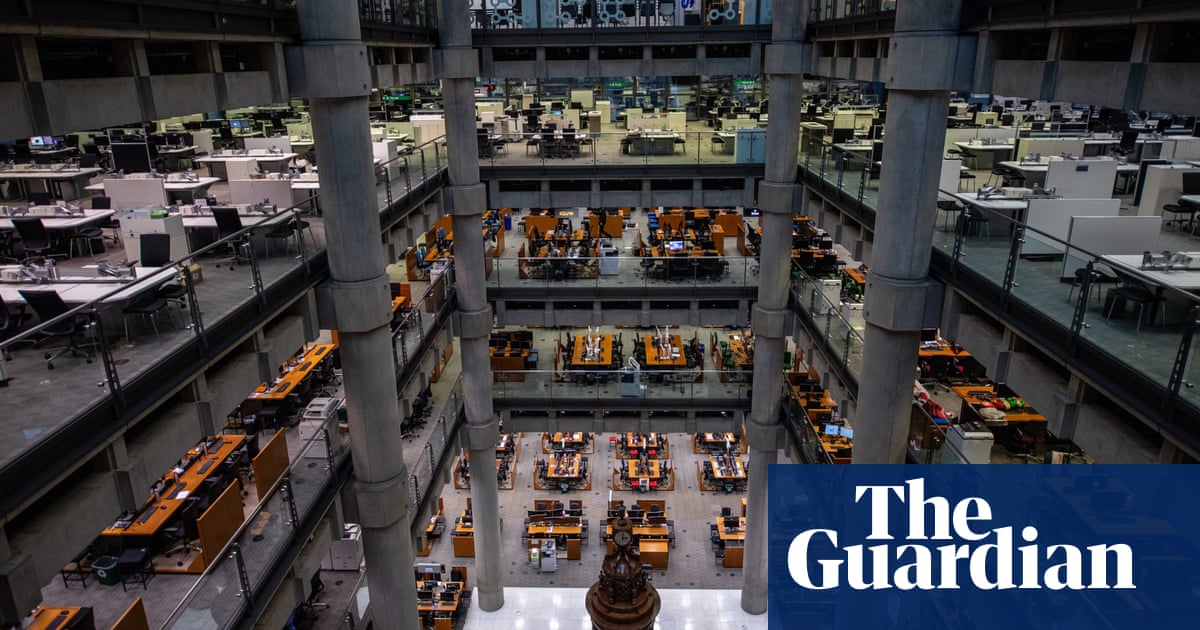
Workers should come into the office at least three days a week – and not just Tuesday to Thursday – to ensure clients are properly served throughout the week, according to the head of the world’s biggest insurance market.
Bruce Carnegie-Brown, the chairman of Lloyd’s of London, said he wants to see people working in its building in the City for most of the week, and to avoid a situation where people were taking “long weekends” every week, and Mondays and Fridays weren’t properly covered for clients.
“We’ve got to make sure that we still work across the working week and that we don’t impede our ability to serve customers by the bookends of the week, defaulting to being a long weekend for everybody every week,” he said. At the moment, workers come in two and a half days a week, on average.
The Lloyd’s underwriting room is being refurbished to make it more appealing, with better technology and more modern desks, and will reopen on 18 September. Carnegie-Brown wants representatives from all 85 insurers that are members of the market to be present throughout the week on the main, ground floor.
“What we’re trying to do now is to make sure that everybody who is an underwriter at Lloyd’s has at least one box on the ground floor … it should make the ground floor much busier and buzzier as a result. That busyness will encourage a positive cycle of broker and underwriter interaction in the room. That’s the intention anyway.”
However, he is not suggesting that people need to be in the office five days a week, recognising the “real gains” of working from home “in terms of people’s sense of well being and fulfilment”.
There has been a general backlash against hybrid working driven by banks such as Lloyds Banking Group and Citigroup, and technology companies including Google, which are demanding that staff spend more time in the office.
Carnegie-Brown made the comments as Lloyd’s said that rising global fears over high interest rates, recession and the climate crisis are prompting more people and businesses to take out insurance policies.
Concerns, including over geopolitical tensions, have led to booming demand for insurance polices despite rising prices, Carnegie-Brown said. The insurance market normally tends to grow at the same rate as global GDP, but is growing three times faster, with strong demand for natural catastrophe, renewable energy and cyber-risk cover.
“What we’ve identified is a huge range of risks out there that seem to be greater at the moment than the average. And so we are seeing our clients buying more protection,” said Carnegie-Brown.
“I see quite a lot of natural catastrophe protection being bought, particularly wind storms, but increasingly around things like wildfires, and renewable energy is increasingly a big part of our business as more and more infrastructure for renewable energy are being built and therefore being insured on the transition to net zero.”
Cyber-risk insurance, which helps organisations pay for any financial losses incurred in the event of a cyber-attack or data breach, has been the fastest-growing line of business at Lloyd’s in the last two years, and it has a 20% share of the global market.
The group’s gross written premiums increased by nearly 22% to £29bn in the first six months of the year, including a 4% currency impact, 9% price rises and a 9% growth rate.
Lloyd’s swung back to a profit before tax of £3.9bn between January and June from a loss of £1.8bn a year earlier, partly because of relatively low big claims. Last year it took a £1.4bn hit from the war in Ukraine, for aircraft stranded in Russia, as well as ships trapped in the Black Sea.
Its biggest single claim so far this year arose from the storms in New Zealand in January, while the wildfires in Hawaii in early August mostly affected domestic insurers. There are usually more natural disasters in the second half of the year, which includes the hurricane season.
Lloyd’s also had a good return on its £80bn investment book – it invests the money it holds to cover future insurance payouts – for the first time in 20 years. Stock markets were the clear outperformers, with the S&P 500 on Wall Street returning 16.9%, largely driven by large technology companies because of the excitement around artificial intelligence, it said.











